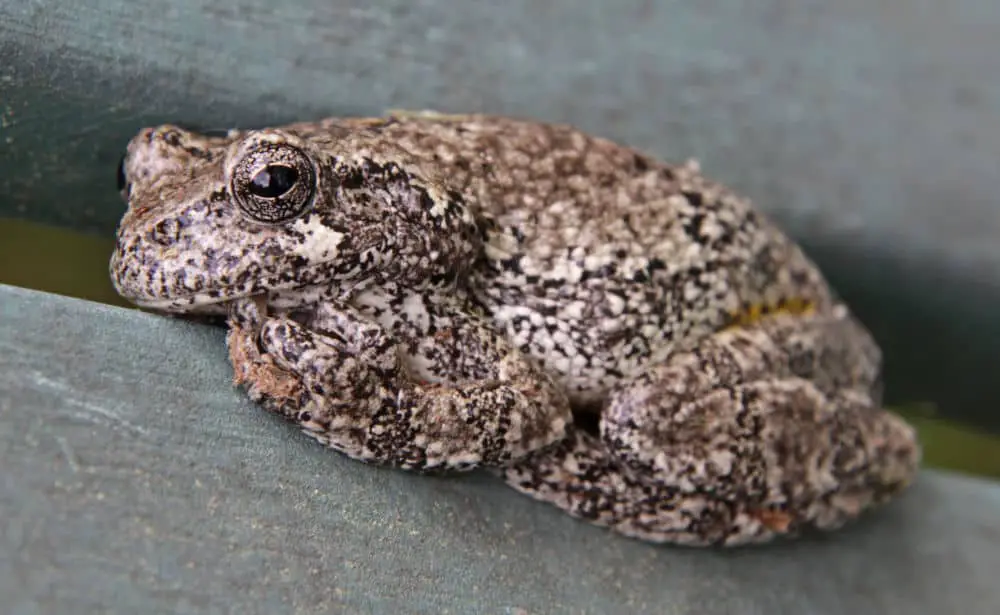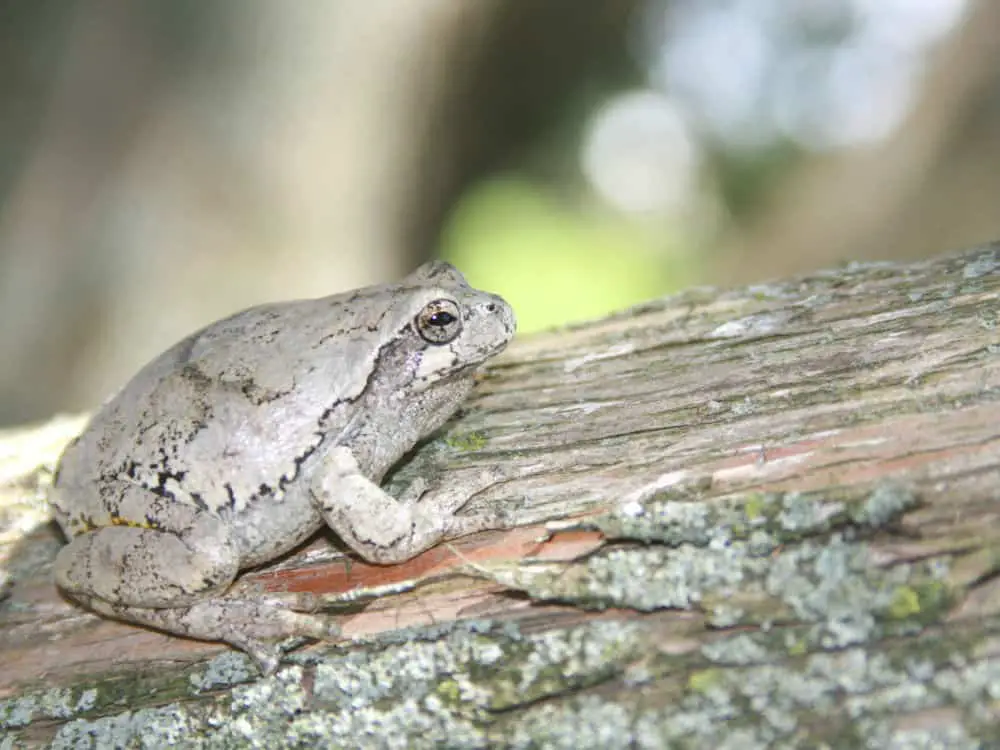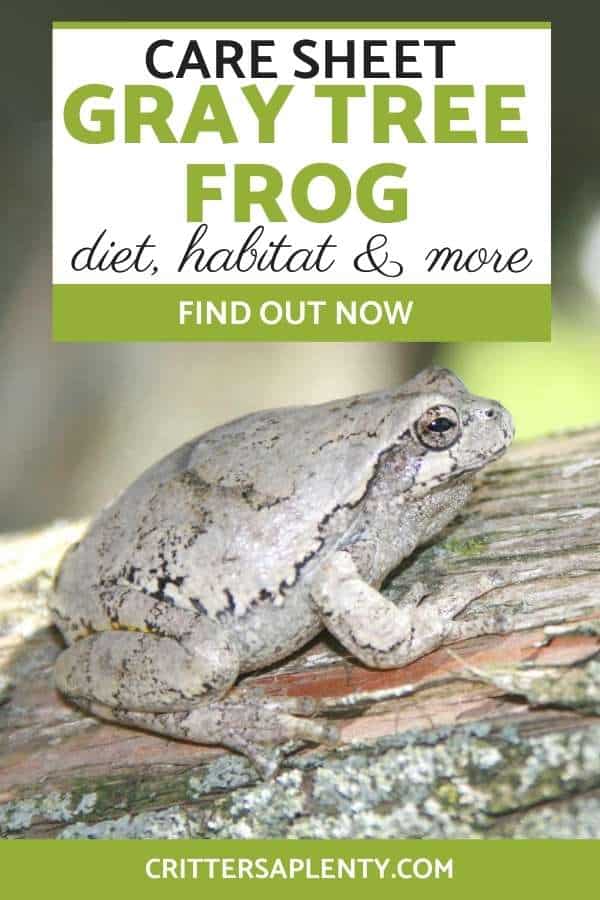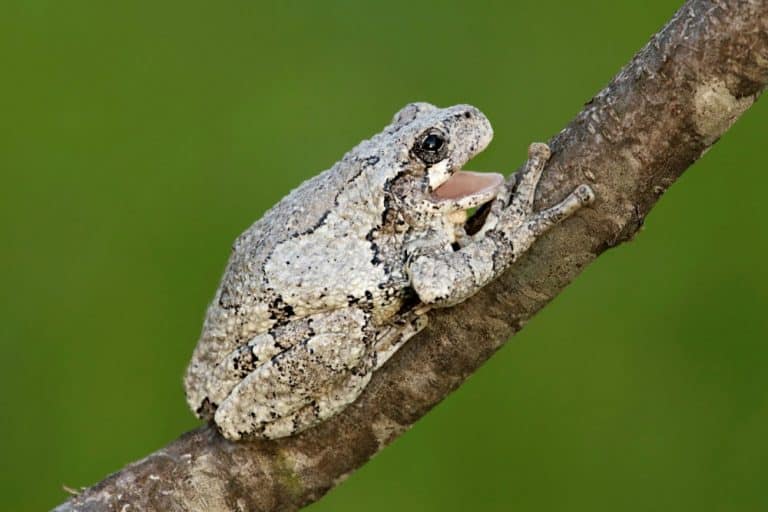Gray Tree Frog Care Sheet: Diet, Habitat, and More
The gray tree frog is one of the most popular tree frogs amongst pet owners. Known for their ability to change from one vibrant color to the next, it’s important you know everything you can about these animals to provide them with a stable and healthy environment.
Ensuring your gray tree frog is housed correctly and feeding them the proper food and supplements are just a few of the factors that you should be mindful of before bringing your frog home. For example, your frog should be housed in a glass enclosure to ensure enough cool air comes in.
In this article, we’ll be exploring everything you need to know about gray tree frogs and how to properly care for them. If you’re interested in learning about a vast number of care methods for your new amphibian friend, keep reading.
Natural Habitat of a Gray Tree Frog
Before we dive into how to properly care for your gray tree frog, let’s explore their natural habitat and where they hail from. You can find these frogs along most of the eastern United States, all the way to southeastern Canada.
It’s easy to see why the gray tree frog would inhabit these areas, as they are keen on moist woodlands and even swamps. Humid climates with plenty of water and trees are ideal for these little creatures, as they will thrive in these conditions.
Gray tree frogs are also known to live up to 7-9 years in the wild and spend most of the days hiding under any covering they can find.
While young frogs usually reside near the forest floor, when these gray tree frogs become older, they tend to reside higher up within the trees of their environment. Now that you have a better understanding of where these creatures reside in the wild, let’s dive into how you can provide for your gray tree frog when they are in your care.
Behavior of a Gray Tree Frog
To properly care for these creatures, it’s important to understand their personalities and how they feel and react to certain things. Below, we’ll explore how these frogs act and behave daily and other factors you should be aware of.
They Are Nocturnal
Since gray tree frogs are nocturnal animals, you’ll only see them active during night time. During the day, you can probably find them hiding and sleeping under different forms of covering such as bark and leaves.
While they are active at night and busy searching for food, during the day, they stay in the same spot, usually near water, and sleep. It’s important to be aware that your gray tree frog is a nocturnal creature before you bring your new friend home.
You should be accustomed to the sight of your gray tree frog being stationary during the day and active at night, as this is normal behavior and a sign they are healthy.
They Use a Specific Sound to Communicate
Gray tree frogs will emit a loud, almost shrill call that usually occurs after dusk.
This type of calling is usually done by the male tree frogs, as they do this to draw in potential mates. This call can go on for hours and is done during the night and evenings when gray tree frogs are active.
Numerous studies have been done about how gray tree frogs emit sounds and how they successfully communicate with others across long distances. While you may never hear this sound coming from your gray tree frog within the confines of their enclosed habitat, it’s common for males in the wild to make this type of call.
They Change Colors
Gray tree frogs also have the ability to change color to match the environment they’re in. Their color is also likely to change based on activity and can range from a variety of colors, light, and dark.
When these creatures feel threatened, a bright yellow or orange color will appear on their thighs to ward off and scare potential predators. Whether the gray tree frog is relaxing or avoiding prey, the changing of their colors allows them to express themselves and their current situation.
They Don’t Like to Be Handled
It’s common knowledge amongst frog owners that their pets don’t care to be handled. This is also the case for the gray tree frog, so it’s best to limit the amount of time you handle your frog to ensure your pet stays happy and stress-free.
It’s perfectly okay to handle your frog when moving them from one container to another, as you’ll have to clean their enclosure often. But as far as anything else goes, it’s ideal to keep handling to the bare minimum.
When you handle your gray tree frog, it’s important to have your hands slightly damp before handling. It’s also vital to stay calm to keep your pet feeling safe and secure, as you don’t want to cause them to become anxious.
It’s important to understand the multiple aspects of how your future gray tree frog may behave. Understanding them and their personality is key to giving them a healthy and happy life in their enclosed environment.
Proper Housing for Your Gray Tree Frog
Now that you understand more about the behavior of the gray tree frog, it’s time to learn more about how you can give them a proper home and environment to thrive in. Below, we’ll go in-depth into what you need to ensure your frog is comfortable and happy in their new home.
Purchasing the Correct Tank
As we stated earlier, your gray tree frog will do best in a glass enclosure, as it will produce enough cool air to keep your pet comfortable.
It’s important to provide your frog with an appropriately sized tank to have enough space to move around. While your gray tree frog may remain still during the day, they will use up all the space available when they are awake.
A 10-gallon tank is a decent size for a single frog, while a 20-gallon aquarium is an appropriate size for up to two of these frogs to live comfortably. If you’re looking for the ideal tank for your pet, this Exo Terra Glass Terrarium is ideal for a single tree frog.
Not only is this tank a perfect choice for your gray tree frog, but it offers your pet enough height to climb and act out its natural behaviors. The front doors of this tank allow easy access to clean and maintain your pet’s environment, while also being designed to prevent unwanted escapes.
It’s also ideal to surround your tank with some sort of aquarium background for your gray tree frog to feel safe and secure in their new home. Purchasing the correct tank for your gray tree frog is the first step to ensuring they have a quality home that they can thrive in.
Size and shape play a big role in the tank you should have available for your frog. A large, vertical tank is ideal for your pet, who will enjoy the space they have to move around and climb freely. A glass exposure is also ideal for your pet, as it will keep them cool and comfortable throughout the day.
Remembering all these factors when looking for the perfect tank for your friend is the first step to creating a liveable environment for your new friend.
Installing Proper Heating
Keeping your gray tree frog’s habitat at a consistent temperature is vital in keeping them healthy and happy. You’ll always want your pet’s environment to stay at a constant 75°F (24°C) for them to be comfortable.
Maintaining this heat can be done by installing a heat mat on one side of your frog’s tank. This will ensure that your frog is always exposed to the appropriate temperature. By keeping your heat mat on one side of the tank, it allows your frog’s environment to maintain a comfortable balance of warm and cool.
This Zilla Heat Mat Terrarium Heater is the perfect product for you and your gray tree frog. You can easily install it on the side or the bottom of your pet’s tank, and it’s an energy-efficient option that doesn’t require any wires.
Installing a heat mat such as this one will help your frog maintain their body temperature while also improving their overall health. To ensure that your new heat mat produces the correct temperature for your frog’s tank, it’s vital you invest in a tank thermostat.
This BN-LINK Digital Thermostat Controller allows you to read and control the temperature within your gray tree frog’s environment. This easy-to-use-and-install product is popular amongst reptile and amphibian owners and will keep you informed and in control of the temperature in your beloved pet’s tank.
It’s important to be aware that the heat mat alone may not be enough to keep your frog’s tank consistent. If that’s the case, you can always install an extra basking bulb that hangs above your pet’s terrarium.
This Exo Terra Swamp Basking Lamp is ideal if you need a little extra heat for your frog’s tank. As long temperatures do not exceed 75-80°F (24-27°C), your gray tree frog will stay happy and content in their new warm and cozy home.
Having UVB Lighting Available
Gray tree frogs require the correct amount of UVB light within their environment to absorb essential nutrients and remain healthy overall. Even though these animals are nocturnal, it’s still ideal to give them access to healthy UVB light.
Vitamin D3 is one of the main vitamins and nutrients your gray tree frog absorbs when in contact with UVB light. Vitamins D3 allows your pet to absorb calcium, which is vital to bone structure and growth.
This Zoo Med Mini Tropical UVB Lighting is a great choice if you’re searching for the right UVB source to keep your gray tree frog healthy and happy. It’s important to regard UVB lighting as essential since your frog could suffer from certain health problems when they aren’t subjected to UVB light.
Factors such as metabolic bone disease can affect your gray tree frog if UVB light is not implemented, so it’s important to install a UVB light source immediately so your frog can begin soaking up the benefits.
Having Interactive Decor
As we stated earlier, your gray tree frog will thoroughly enjoy acting out natural behaviors such as climbing. To ensure they can act out these healthy behaviors, having interactive decor inside their tank is necessary.
This Zoo Med Mushroom Ledge is a great example of interactive decor that you can implement into your frog’s tank. This mushroom ledge allows your frog to not only climb but sit at elevated levels just as they do in their natural habitat.
While your frog will naturally climb all over the glass of their tank, a ledge like this gives them a fun way to explore their tank from new and exciting heights. Some of the ledges available have water and food bowls attached, so there are plenty of different options to choose from.
Another great accessory to add to your gray tree frog’s tank is vines. This gives your pet another opportunity to climb and explore their environment in different and creative ways. Fluker’s Repta Vines is a popular choice amongst reptile and amphibian owners alike and will help keep your frog healthy and active.
While these types of vines are a great choice for any enclosure, they are ideal for vertical terrains, as it will encourage your little frog to climb upwards. Vines are also a visually appealing way to liven up any tank while ensuring your gray tree frog gets the most out of their new environment.
Another key piece of decor that also serves a fundamental purpose for your tree frog is a “hide.” A hide provides shelter to your pet, as well as an ideal hiding space.
Seeing how the gray tree frog is a nocturnal creature, it may spend the majority of the day sleeping underneath hides. There are various looking hides to choose from, ranging from ones that look like mossy logs to dinosaur skulls. Either way, hides give your pet a safe place to retreat when they are sleeping or feeling anti-social.
This Zilla Reptile Habitat Rock Den is an ideal choice for your gray tree frog, as it’s large enough for your pet to swiftly enter and exit their hide without any problem. It’s also a visually pleasing rock formation that will appear realistic within your frog’s tank.
It’s important to remember that while decor in your frog’s tank should be pleasing to the eye, you also want your frog to be able to interact with the decor you choose to use. Implementing interactive decor within your frog’s tank keeps them healthy and active, as they’ll be able to do a variety of things such as hide and climb.
Using the Correct Substrate
If you’re searching for the correct substrate for your frog’s tank, you have several options.
One of the most popular kinds of substrate used for gray tree frog tanks is coconut husk fiber substrate. This is a safe option and will not harm your pet, like some forms of substrate can. This Zoo Med Eco Earth Coconut Fiber Substrate is a safe and eco-friendly option that will have positive health benefits on your frog, all while keeping them safe.
You can also just opt for regular soil, as long as you avoid anything fertilized, which is usually swarmed with chemicals and can negatively affect your frog. It’s also best to avoid substrates such as aquarium gravel or sand.
Using the wrong kind of substrate can lead to impaction, which occurs when small substrates are consumed and not digested. This can lead to major health problems and even death, so it’s best to avoid these options.

Providing Your Frog With Proper Food/Water/Supplements
While the gray tree frog is nocturnal, they are still known to eat at all hours of the day. Although this is the case, it’s important you stick to a regular feeding schedule so your frog will know when to expect their next meal.
For food, insects such as mealworms, crickets, waxworms, and hornworms are a safe and nutritious choice for your gray tree frog. It’s also recommended you gut load your crickets and worms before you feed them to your frog, to pass on all the benefits from one creature to another.
This Vita-Bug Adult Live Crickets is a popular choice amongst reptile and amphibian owners as they make a delicious meal for your pet that contains lots of protein, vitamins, and nutrients.
These Fluker’s Gourmet-Style Mealworms are another delicious option for your frog, as it’s also packed with vitamins and minerals. It’s also an ideal food source if you’re not interested in live feedings. If you’re looking for a way to keep your gray tree frog healthy and satisfied, look no further than the products we’ve linked above.
As for the water your frog should be consuming, there should always be a small dish available in your pet’s tank. You should clean the water bowl every other day and ensure the water in the bowl is always fresh and clean for your frog.
To keep your gray tree frog in the best of health, a variety of supplements are encouraged. For your frog to consume essential nutrients, such as calcium, specific supplements need to be taken.
Most of these supplements are available in powdered form and can be easily sprinkled onto your tree frog’s food. If you’re looking for the ideal supplement for your pet, this Zoo Med Repti Calcium Supplement is a great choice that will allow your frog to receive all the calcium they need to stay healthy.
Simply dust your supplement onto whatever your frog is consuming until it is completely covered, and your gray free frog will be all set.
Cleaning Your Frog’s Tank Properly
Earlier, we discussed how to choose the proper tank for your gray tree frog and all the other pieces of equipment you’ll need to create an ideal environment for your pet. But cleaning out your frog’s tank regularly is just as important.
It’s vital that you completely clean out your frog’s tank at least once a week. This will consist of placing your tree frog in another location while you do things such as replace the substrate, clean the glass, and rinse any of the decors you may have in the tank.
While you should do a deep clean at least once a week, it’s important to do a spot clean every day or at least every other to ensure your frog’s environment is clean and liveable. If you’re looking for a safe cleaner to use on the inside of your frog’s terrarium, this Zoo Med Wipe Out Cage Cleaner is just what you need.
This product kills bacteria instantly and will keep your pet healthier in the long run. It’s recommended that you only use this product once a week, as it is powerful, but it will get the job done.
Breeding Your Gray Tree Frog
If you’re planning on keeping multiple gray tree frogs in one enclosure together, and plan on them breeding, there are a few factors you should be aware of.
The best way you can encourage breeding between your gray tree frog is through a process called cycling. Cycling occurs when reptile and amphibian owners manipulate factors within their animal’s environment to mimic their natural environment.
Factors such as temperature, humidity, and rainfall can all be produced within the confines of your frog’s tank to give the impression that the seasons are changing. This, in turn, will encourage mating behaviors amongst your gray tree frogs.
If you are successful in this, you’ll begin to hear the male making calls to the female they are with. Factors such as temperature, rain, and humidity can be easily adjusted. If done correctly, you can easily give off the impression that the seasons are changing for your gray tree frogs.
Since mating occurs while frogs are floating in the water, eggs will be deposited within the water, and you can expect to find tadpoles swimming around in about 3-7 days.
Health Problems to Be Aware of
Before you bring any new pet home, you should be aware of the common health problems of that animal and how to avoid it and treat it.
Nutritional Deficiencies
A common health problem gray tree frogs can face is nutritional deficiencies. This can occur if your frog does not consume the required amount of vitamins and nutrients it needs to survive, such as calcium.
Signs of nutritional deficiencies include weak hind legs and lethargy, so it’s important to act fast if you notice any one of these signs appear. If you believe your frog may be suffering from a nutritional deficiency, consult your exotic animal veterinarian, and begin implementing more supplements into your frog’s diet.
Skin Issues
Skin problems are common among gray tree frogs, and can even result in bacterial or fungal infections. If you spot abrasions on your frog’s skin, you should consult your veterinarian to see what the cause of your pet’s skin issues is.
Intestinal Obstruction
Another common health problem to be mindful of is intestinal obstruction.
This can occur when your pet has consumed too many hard-shelled insects or even harmful substrate. When your pet consumes these things but can’t digest them, this can lead to serious health problems and discomfort.
If you feel as if your frog is suffering from intestinal obstruction, it’s important you contact your local veterinarian immediately, as surgery may be required. Being mindful of some of the health problems your gray tree frog may face will keep you informed and attentive in terms of what to look out for.
Chemical Intoxication
Your tree frog is also susceptible to chemical intoxication if they come into contact with dangerous pesticides or cleaners.
This is why it’s vital to use safe cleaning agents when cleaning out your pet’s tank. Exposure to soaps and detergents can also cause chemical intoxication, so it’s important to be mindful of what you’re using near your gray tree frog.
Your best bet is to visit your local veterinarian once again and avoid using certain cleaners and chemicals in your frog’s tank immediately.
Conclusion
Hopefully, now you have a better understanding of the gray tree frog and how you can properly care for yours.
In this article, we discussed factors such as what tank you should keep your pet in, how to properly handle them, what to feed them, and common health problems you should be aware of.
We also learned that gray tree frogs are incredibly skilled and intelligent creatures, and they can be a joy to have as a pet if you’re well informed.
Being knowledgeable about your new pet is key to keeping them happy, healthy, and living a long life. Now that you have all the information you need to get started, you’re reading to bring your gray tree frog home.



